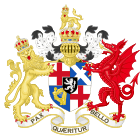Humble Petition and Advice facts for kids

|
|
| Introduced by | Sir Christopher Packe |
|---|---|
| Territorial extent | |
| Dates | |
| Commencement | 25 May 1657 |
| Other legislation | |
| Amended by | The removal of the "monarchy" clause |
| Repealed by | Declaration of Breda Indemnity and Oblivion Act |
| Relates to | Instrument of Government |
|
Status: Repealed
|
|
The Humble Petition and Advice was an important set of rules for how England was governed. It was the second and last written plan for the country's government after the Instrument of Government.
Contents
What Was the Humble Petition and Advice?
On February 23, 1657, during a meeting of the Second Protectorate Parliament, a man named Sir Christopher Packe presented a document. Packe was a Member of Parliament and a former Lord Mayor of London. This document became known as the Humble Petition and Advice.
He gave it to Lord Protector Oliver Cromwell, who was the leader of England at the time. Even though Packe presented it, he was not the person who wrote it.
Why Was This Document Created?
This important document came about because a new group of Cromwell's supporters, called the New Cromwellians, were becoming more powerful. Many of these people were moderate Presbyterians. They wanted to see some changes in how England was run.
They hoped to bring back a form of monarchy (having a king or queen). They also wanted to limit the power of the leader, just like in older times. People also wanted less military control in the government. Cromwell himself was not feeling well and was frustrated that people didn't share his strong ideas for change.
What Did the Petition Ask For?
The Humble Petition and Advice had several main goals. It wanted to offer Oliver Cromwell the chance to become a king, and for his children to inherit the role. It also aimed to give Parliament more control over new taxation (collecting money).
The document also suggested creating a special council to advise the king. It wanted to make sure Parliament met regularly, every three years. Another goal was to make the army smaller to save money. All these ideas were meant to limit Cromwell's power, not increase it.
Rules for Religious Groups
Some parts of the Petition were very strict for certain religious groups. Clauses 10 to 12 put strong limits on groups like the Fifth Monarchists and Baptists. At the same time, it tried to bring back a national church organized in the Presbyterian way.
Cromwell's Decision
Oliver Cromwell refused the offer to become king on May 8, 1657. Historians still wonder why he said no. One popular idea is that he worried his army would not like it, especially if it meant making the army smaller.
Other reasons might be that he didn't want people to think he was trying to build a family dynasty. Some believe he truly didn't think England needed a king. He might also have feared that bringing back a monarchy would go against what he believed God had decided after the First English Civil War.
Changes to the Petition
After Cromwell refused the crown, the Humble Petition and Advice was changed. The part about offering kingship was removed. It was also changed to include a second chamber (like a second house of Parliament) because of a legal case known as the Naylor case.
On May 25, Cromwell officially approved the changed Humble Petition and Advice. He also said that he would choose his own successor as Lord Protector.
Sources
- Coward, Barry, The Cromwellian Protectorate New frontiers in history, Manchester University Press, 2002 0719043174, 9780719043178
- Fritze, Ronald H. & Robison, William B. Historical dictionary of Stuart England, 1603-1689, Greenwood Publishing Group, 1996. ISBN: 0-313-28391-5, ISBN: 978-0-313-28391-8
- Lee, Sidney (1903), Dictionary of National Biography Index and Epitome
- Noble, Mark. Memoirs of the protectoral-house of Cromwell: deduced from an early period, and continued down to the present time; ... collected chiefly from original papers and records, ... together with an appendix: ... Embellished with elegant engravings. Volume 1, The third edition, Printed for G. G. J. and J. Robinson, 1787. page 416.

